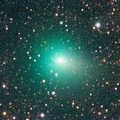
|
Now it is very bright as 9.0 mag (May 5, Carlos Labordena). It stays observable in excellent condition for a while. It will be fading after this, and it will fade down to 13 mag at the end of May. But it may stay bright for some more time.
Date(TT) R.A. (2000) Decl. Delta r Elong. m1 Best Time(A, h)
May 8 12 29.75 30 42.7 0.709 1.497 120 10.4 21:20 ( 0, 85)
May 15 11 45.82 27 25.1 0.920 1.576 109 11.3 20:34 ( 34, 81)
|
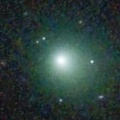
|
It brightened rapidly. Now it is very bright as 10.7 mag (May 3, Michael Jager). It stays observable at 11 mag in good condition for a long time from spring to summer.
Date(TT) R.A. (2000) Decl. Delta r Elong. m1 Best Time(A, h)
May 8 13 41.89 30 54.6 1.416 2.192 128 11.2 22:36 ( 0, 86)
May 15 13 38.77 29 2.7 1.415 2.164 125 11.1 22:05 ( 0, 84)
|
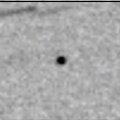
|
Now it is 11.2 mag (Apr. 19, Chris Wyatt). Appearing in the morning sky in the Southern Hemisphere. In the Northern Hemisphere, it will appear in the morning sky in June.
Date(TT) R.A. (2000) Decl. Delta r Elong. m1 Best Time(A, h)
May 8 0 43.30 -1 57.9 2.138 1.489 38 12.0 3:26 (270, -4)
May 15 1 2.95 -0 28.7 2.137 1.513 40 12.1 3:18 (268, -3)
|

|
Now it is 12.3 mag (Apr. 28, Thomas Lehmann). Brightenening very rapidly. It will brighten up to 11 mag from May to August. In the Southern Hemisphere, it stays observable in excellent condition for a long time. In the Northern Hemisphere, it stays observable in good condition for a while. But it becomes extremely low after July.
Date(TT) R.A. (2000) Decl. Delta r Elong. m1 Best Time(A, h)
May 8 19 57.60 1 33.2 0.540 1.257 104 12.5 3:26 (324, 51)
May 15 20 24.56 -1 30.8 0.505 1.243 105 12.2 3:18 (323, 47)
|
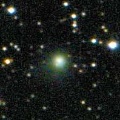
|
Now it is 12.8 mag (Apr. 27, Thomas Lehmann). It will brighten up to 10 mag in winter in 2022. In the Northern Hemisphere, it stays observable in good condition for a long time, although it becomes extremely low temporarily from May to June. In the Southern Hemisphere, it is not observable until November.
Date(TT) R.A. (2000) Decl. Delta r Elong. m1 Best Time(A, h)
May 8 3 29.94 50 39.0 4.986 4.190 34 12.7 20:26 (146, 11)
May 15 3 43.59 50 33.2 4.981 4.158 31 12.7 20:34 (149, 8)
|
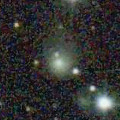
|
Now it is 13.5 mag (May 8, Sandor Szabo). It is expected to be observable at 5-6 mag for a long time from 2022 to 2023. In the Northern Hemisphere, it is not observable at the high light from 2022 summer to 2023 summer. In the Southern Hemisphere, it stays extremely low for a while. But it will be observable in good condition at the high light.
Date(TT) R.A. (2000) Decl. Delta r Elong. m1 Best Time(A, h)
May 8 18 17.77 42 31.2 6.092 6.428 105 13.0 3:15 (180, 82)
May 15 18 13.55 42 56.7 5.996 6.371 107 12.9 2:43 (180, 82)
|
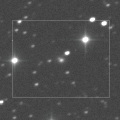
|
Now it is 12.9 mag (Apr. 19, Chris Wyatt). It stays 13 mag until early summer. In the Southern Hemisphere, it stays observable in good condition for a long time. It is getting higher slowly also in the Northern Hemisphere.
Date(TT) R.A. (2000) Decl. Delta r Elong. m1 Best Time(A, h)
May 8 15 48.68 -32 11.7 2.389 3.360 161 13.0 0:48 ( 0, 23)
May 15 15 29.01 -29 54.4 2.367 3.364 168 13.0 0:01 ( 0, 25)
|
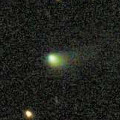
|
Now it is 14.4 mag (Apr. 19, Chris Wyatt). It stays 13-14 mag from 2020 to 2021. It will be observable in good condition after this in the Southern Hemisphere. It locates somewhat low in the Northern Hemisphere.
Date(TT) R.A. (2000) Decl. Delta r Elong. m1 Best Time(A, h)
May 8 19 27.68 -26 34.1 2.282 2.892 117 13.7 3:26 (345, 27)
May 15 19 29.55 -27 14.0 2.208 2.898 124 13.6 3:18 (350, 27)
|
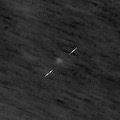
|
Now it is 15.6 mag (Apr. 21, Slooh.com Canary Islands Observatory). It will brighten up to 10 mag from summer to autumn, and it will be observable in excellent condition. Appearing in the morning sky.
Date(TT) R.A. (2000) Decl. Delta r Elong. m1 Best Time(A, h)
May 8 23 48.65 2 55.3 2.548 2.032 48 14.0 3:26 (273, 10)
May 15 0 4.07 4 23.3 2.459 1.994 51 13.7 3:18 (273, 12)
|
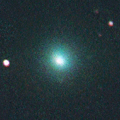
|
It brightened up to 10.5 mag in early March (Mar. 8, Bob King). Now it is fading. But it is still bright as 13.6 mag (Apr. 21, Ken-ichi Kadota). In the Northern Hemisphere, it stays observable in the evening low sky until early June while the comet will be fading. It is not observable in the Southern Hemisphere.
Date(TT) R.A. (2000) Decl. Delta r Elong. m1 Best Time(A, h)
May 8 5 21.24 33 20.6 2.185 1.487 35 13.9 20:26 (119, 17)
May 15 5 48.33 32 23.2 2.301 1.575 34 14.3 20:34 (119, 15)
|
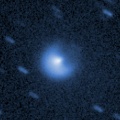
|
Now it is not observable. It will appear in the morning sky in July.
Date(TT) R.A. (2000) Decl. Delta r Elong. m1 Best Time(A, h)
May 8 3 25.50 26 42.8 6.864 5.878 11 14.0 20:26 (130, -7)
May 15 3 31.65 27 1.8 6.878 5.880 8 14.0 20:34 (135,-11)
|
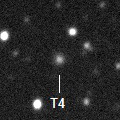
|
Now it is 14.5 mag (Apr. 30, Chris Wyatt). It is expected to brighten up to 11.5 mag in 2022. It is observable in excellent condition in the Southern Hemisphere. In the Northern Hemisphere, it is observable in the low sky until May.
Date(TT) R.A. (2000) Decl. Delta r Elong. m1 Best Time(A, h)
May 8 8 14.82 -28 12.2 5.267 5.337 88 14.2 20:26 ( 43, 12)
May 15 8 19.47 -27 18.0 5.305 5.304 84 14.2 20:34 ( 49, 8)
|

|
It brightened up to 11.6 mag in winter (Feb. 18, Thomas Lehmann). Now it is fading. It has already faded down to 14.3 mag (Apr. 30, Chris Wyatt). In the Southern Hemisphere, it stays observable in good condition after this. In the Northern Hemisphere, it will never be observable after this.
Date(TT) R.A. (2000) Decl. Delta r Elong. m1 Best Time(A, h)
May 8 4 28.62 -56 27.0 2.669 2.612 75 14.3 20:26 ( 42,-37)
May 15 4 36.15 -55 6.8 2.744 2.674 75 14.4 20:34 ( 44,-41)
|
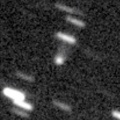
|
Now it is 14.9 mag (Apr. 19, Chris Wyatt). It was expected to brighten up to 13 mag from spring to summer. But actually, it is fainter than originally expected. It stays 14-15 mag until early autumn. In the Southern Hemisphere, it stays observable in good condition for a long time. In the Northern Hemisphere, it is not observable until July in 2022.
Date(TT) R.A. (2000) Decl. Delta r Elong. m1 Best Time(A, h)
May 8 20 41.27 -75 28.7 3.185 3.620 107 14.5 3:26 (351,-22)
May 15 21 1.84 -77 2.4 3.145 3.613 109 14.5 3:18 (352,-24)
|
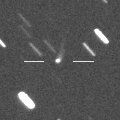
|
It will brighten up to 14.5 mag from spring to summer. In the Southern Hemisphere, it stays observable in excellent condition for a long time. In the Northern Hemisphere, it is not observable after this.
Date(TT) R.A. (2000) Decl. Delta r Elong. m1 Best Time(A, h)
May 8 1 5.63 -57 44.5 2.663 2.651 78 14.8 3:26 (321,-34)
May 15 1 33.46 -60 17.6 2.595 2.657 82 14.7 3:18 (323,-35)
|

|
Now it is 15.3 mag (May 8, Sandor Szabo). It will stay at 14-15 mag for a long time from 2021 to 2022. It stays observable in good condition after this while brightening gradually.
Date(TT) R.A. (2000) Decl. Delta r Elong. m1 Best Time(A, h)
May 8 18 2.50 0 18.1 4.452 5.179 131 14.9 3:00 ( 0, 55)
May 15 17 56.40 -0 10.4 4.361 5.165 138 14.8 2:27 ( 0, 55)
|
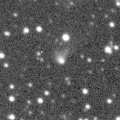
|
Now it is 15.3 mag (Apr. 19, Chris Wyatt). It stays 14-15 mag until the end of 2021. In the Southern Hemisphere, it stays observable in good condition for a long time. In the Northern Hemisphere, it is not observable until June.
Date(TT) R.A. (2000) Decl. Delta r Elong. m1 Best Time(A, h)
May 8 23 26.64 -36 54.9 4.517 4.342 73 15.0 3:26 (309,-10)
May 15 23 31.20 -36 21.7 4.438 4.347 78 14.9 3:18 (310, -7)
|
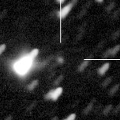
|
Now it is 15.6 mag (Apr. 12, Chris Wyatt). It stays 15 mag until summer. In the Southern Hemisphere, it stays observable in good condition until June. In the Northern Hemisphere, it is observable in the low sky from March to May.
Date(TT) R.A. (2000) Decl. Delta r Elong. m1 Best Time(A, h)
May 8 7 19.90 -11 48.3 2.250 2.136 70 15.1 20:26 ( 64, 15)
May 15 7 31.97 -8 18.6 2.299 2.105 66 15.0 20:34 ( 71, 12)
|

|
Now it is very bright as 13.3 mag (May 10, Alan Hale). It will brighten very rapidly, and it will brighten up to 10 mag from July to August. It stays observable in the morning sky for a long time.
Date(TT) R.A. (2000) Decl. Delta r Elong. m1 Best Time(A, h)
May 8 22 45.44 -15 26.7 1.308 1.360 70 15.7 3:26 (298, 11)
May 15 23 14.04 -12 28.1 1.239 1.299 69 15.1 3:18 (294, 11)
|

|
Now it is 14.4 mag (May 7, Sandor Szabo). It will brighten up to 13 mag in 2022. In 2021, it is observable at 14-15 mag in good condition.
Date(TT) R.A. (2000) Decl. Delta r Elong. m1 Best Time(A, h)
May 8 13 7.14 0 3.1 2.734 3.626 147 15.3 22:01 ( 0, 55)
May 15 13 3.88 0 4.2 2.776 3.611 140 15.3 21:30 ( 0, 55)
|
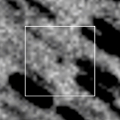
|
Now it is 17.5 mag (Apr. 20, J.-F. Soulier). Brightening very rapidly. It will brighten up to 8.5 mag from September to October. But the condition is bad in this apparition. In the Northern Hemisphere, it is observable only in the extremely low sky until July. In the Southern Hemisphere, it will be observable after late August. But it stays locating low for a while.
Date(TT) R.A. (2000) Decl. Delta r Elong. m1 Best Time(A, h)
May 8 1 57.66 45 6.5 2.670 1.877 30 15.7 3:26 (222, 11)
May 15 2 22.86 45 24.0 2.612 1.805 29 15.4 3:18 (221, 10)
|
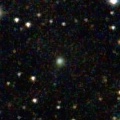
|
Now it is 15.6 mag (May 8, Sandor Szabo). In the Northern Hemisphere, it stays observable at 15-16 mag for a long time from spring to early 2022. In the Southern Hemisphere, it is not observable until the end of 2021.
Date(TT) R.A. (2000) Decl. Delta r Elong. m1 Best Time(A, h)
May 8 18 47.61 77 53.0 3.194 3.175 79 15.5 3:26 (181, 47)
May 15 17 43.70 79 51.4 3.174 3.153 79 15.5 2:14 (180, 45)
|

|
Now it is 15.4 mag (Apr. 19, Toshihiko Ikemura, Hirohisa Sato). In the Northern Hemisphere, it stays observable for a long time while it is getting fainter slowly. In the Southern Hemisphere, it will never be observable again.
Date(TT) R.A. (2000) Decl. Delta r Elong. m1 Best Time(A, h)
May 8 14 29.18 68 37.1 5.666 5.827 94 15.5 23:21 (180, 57)
May 15 14 16.10 67 50.8 5.746 5.875 92 15.6 22:41 (180, 57)
|

|
It has not been observed yet in this apparition. The condition of this apparition is bad. It brightens up to 15.5 mag in spring, however, it is not observable until autumn when it becomes fainter than 19 mag.
Date(TT) R.A. (2000) Decl. Delta r Elong. m1 Best Time(A, h)
May 8 2 50.22 17 41.8 2.247 1.239 2 15.7 3:26 (234,-16)
May 15 3 16.54 19 48.6 2.235 1.226 2 15.6 3:18 (231,-16)
|

|
It had been observed as 8-9 mag for a long time in 2020. Now it is fading. It has already faded down to 16.4 mag (Mar. 27, Thomas Lehmann). It will be observable in good condition after this in the Southern Hemisphere. It locates extremely low after this in the Northern Hemisphere.
Date(TT) R.A. (2000) Decl. Delta r Elong. m1 Best Time(A, h)
May 8 17 25.55 -43 48.4 3.762 4.574 139 15.7 2:24 ( 0, 11)
May 15 17 18.45 -44 34.6 3.771 4.638 145 15.7 1:49 ( 0, 10)
|
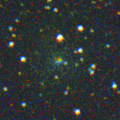
|
Now it is 15.8 mag (Jan. 16, Slooh.com Canary Islands Observatory). It is not observable until June.
Date(TT) R.A. (2000) Decl. Delta r Elong. m1 Best Time(A, h)
May 8 1 28.33 20 47.9 3.068 2.165 21 15.7 3:26 (245, 1)
May 15 1 42.78 22 37.6 3.058 2.180 24 15.8 3:18 (244, 3)
|
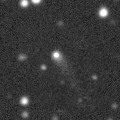
|
Now it is 16.0 mag (May 7, Sandor Szabo). It stays observable at 16 mag from 2021 to 2022. Toshihiko Ikemura and Hirohisa Sato reported it was very bright as 14.2 mag on Apr. 19.
Date(TT) R.A. (2000) Decl. Delta r Elong. m1 Best Time(A, h)
May 8 13 54.32 -10 42.6 3.869 4.843 162 15.7 22:48 ( 0, 44)
May 15 13 50.29 -9 10.1 3.897 4.830 154 15.7 22:17 ( 0, 46)
|
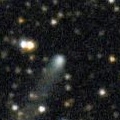
|
Now it is 15.7 mag (May 8, Sandor Szabo). It stays 15-16 mag until July. In the Northern Hemisphere, it stays observable in good condition for a long time. In the Southern Hemisphere, it will be observable in the extremely low sky only in next spring.
Date(TT) R.A. (2000) Decl. Delta r Elong. m1 Best Time(A, h)
May 8 19 0.64 50 2.8 5.000 5.180 94 15.8 3:26 (198, 74)
May 15 18 52.65 51 43.5 4.996 5.207 96 15.8 3:18 (182, 73)
|

|
Now it is 16.0 mag (Apr. 4, Michael Jager). Toshihiko Ikemura and Hirohisa Sato reported it was bright as 14.7 mag on Apr. 18. It is expected to brighten up to 13 mag in 2022. In the Southern Hemisphere, it stays observable in good condition for a long time. In the Northern Hemisphere, it stays observable until June, but it will not be observable at the high light.
Date(TT) R.A. (2000) Decl. Delta r Elong. m1 Best Time(A, h)
May 8 12 42.87 -20 48.1 4.007 4.889 147 15.9 21:37 ( 0, 34)
May 15 12 35.09 -20 42.1 4.028 4.843 139 15.9 21:01 ( 0, 34)
|
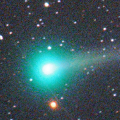
|
It brightened up to 5.6 mag in early December (Dec. 9, Marco Goiato). In mid December, it was visible at about 3 mag in the SOHO spacecraft images (Dec. 18, Hirohisa Sato). Appearing in the morning sky.
Date(TT) R.A. (2000) Decl. Delta r Elong. m1 Best Time(A, h)
May 8 23 56.40 13 51.9 3.339 2.707 44 15.9 3:26 (263, 15)
May 15 0 2.24 14 45.9 3.359 2.802 49 16.1 3:18 (264, 18)
|
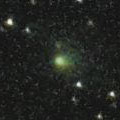
|
It brightened rapidly. Now it is bright as 15.8 mag (May 5, Katsumi Yoshimoto). It will be fading after this, and it will be fainter than 18 mag in July.
Date(TT) R.A. (2000) Decl. Delta r Elong. m1 Best Time(A, h)
May 8 13 10.32 7 56.2 1.497 2.383 143 16.2 22:03 ( 0, 63)
May 15 12 46.68 5 31.5 1.582 2.394 133 16.3 21:12 ( 0, 60)
|
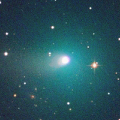
|
Brightened rapidly, and it brightened up to 9.7 mag in November (Nov. 15, Chris Wyatt). Now it is fading. It has already faded down to 15.9 mag (Apr. 30, Catalina Sky Survey). In the Northern Hemisphere, it stays observable in good condition for a long time. In the Southern Hemisphere, it locates extremely low after this.
Date(TT) R.A. (2000) Decl. Delta r Elong. m1 Best Time(A, h)
May 8 7 18.31 37 18.4 2.573 2.243 59 16.3 20:26 (112, 40)
May 15 7 34.63 36 25.9 2.688 2.293 56 16.5 20:34 (113, 36)
|
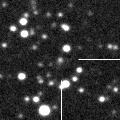
|
Now it is 16.3 mag (Apr. 19, Toshihiko Ikemura, Hirohisa Sato). It stays at 16-17 mag from 2020 to 2021. In the Northern Hemisphere, it stays observable in good condition for a long time. It locates extremely low in the Southern Hemisphere.
Date(TT) R.A. (2000) Decl. Delta r Elong. m1 Best Time(A, h)
May 8 19 43.63 44 50.7 8.754 8.827 90 16.3 3:26 (230, 73)
May 15 19 41.31 45 50.1 8.708 8.828 93 16.3 3:18 (219, 75)
|
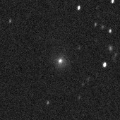
|
Now it is 16.4 mag (Apr. 24, ATLAS-MLO, Mauna Loa). It is observable at 16.5 mag from spring in 2020 to summer in 2021.
Date(TT) R.A. (2000) Decl. Delta r Elong. m1 Best Time(A, h)
May 8 17 3.18 -15 52.3 3.956 4.859 150 16.4 2:01 ( 0, 39)
May 15 16 53.40 -16 23.8 3.918 4.876 159 16.4 1:24 ( 0, 39)
|
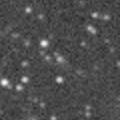
|
Now it is 16.6 mag (Apr. 21, Toshihiko Ikemura, Hirohisa Sato). It stays observable at 16.5-17 mag in good condition until October.
Date(TT) R.A. (2000) Decl. Delta r Elong. m1 Best Time(A, h)
May 8 17 24.55 -28 0.9 4.081 4.941 144 16.5 2:22 ( 0, 27)
May 15 17 19.92 -26 59.3 4.011 4.931 152 16.4 1:50 ( 0, 28)
|
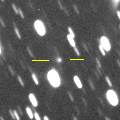
|
Now it is 16.5 mag (Apr. 20, Toshihiko Ikemura, Hirohisa Sato). It is observable at 16 mag from 2020 to 2021. In the Southern Hemisphere, it is not observable until summer.
Date(TT) R.A. (2000) Decl. Delta r Elong. m1 Best Time(A, h)
May 8 23 18.04 43 23.7 6.511 5.965 53 16.5 3:26 (238, 35)
May 15 23 19.10 43 39.7 6.459 5.969 57 16.4 3:18 (238, 38)
|
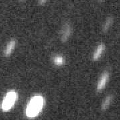
|
Now it is 16.4 mag (May 8, Sandor Szabo). It is expected to brighten up to 11 mag in 2023. In the Northern Hemisphere, it stays observable in good condition for a long time. It locates extremely low in the Southern Hemisphere.
Date(TT) R.A. (2000) Decl. Delta r Elong. m1 Best Time(A, h)
May 8 18 11.21 48 46.1 6.558 6.835 101 16.6 3:08 (180, 76)
May 15 18 4.13 49 28.1 6.485 6.790 103 16.5 2:34 (180, 76)
|
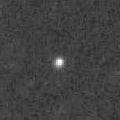
|
Now it is 16.7 mag (Apr. 27, ATLAS-HKO, Haleakala). It is expected to brighten up to 10 mag in 2023. In the Northern Hemisphere, it stays observable in good condition until 2023 autumn. In the Southern Hemipshere, it stays extremely low until mid July, then it becomes unobservable for a while. But it becomes observable in good condition after 2023 summer.
Date(TT) R.A. (2000) Decl. Delta r Elong. m1 Best Time(A, h)
May 8 12 19.72 38 59.2 6.894 7.343 112 16.9 21:14 (180, 86)
May 15 12 15.51 39 1.7 6.932 7.290 106 16.8 20:42 (180, 86)
|
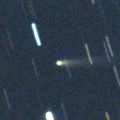
|
First return of a new periodic comet which brightened up to 14-15 mag in 2006. It brightened up to 14.5 mag in March (Mar. 16, F. Kugel, J.-G. Bosch). Now it is fading. It has already faded down to 16.7 mag (Apr. 27, Thomas Lehmann). It will be fainter than 18 mag in June.
Date(TT) R.A. (2000) Decl. Delta r Elong. m1 Best Time(A, h)
May 8 13 16.80 20 53.9 1.217 2.055 134 16.8 22:11 ( 0, 76)
May 15 13 18.28 20 2.7 1.295 2.093 129 17.1 21:45 ( 0, 75)
|
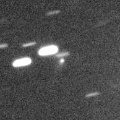
|
Now it is 16.7 mag (Apr. 19, Toshihiko Ikemura, Hirohisa Sato). It will approach to Earth down to 0.2 a.u. in December, and it is expected to brighten up to 4 mag. In the Northern Hemisphere, it stays observable in good condition for a long time until December while the comet is brightening gradually. In the Southern Hemisphere, it is not observable until mid December.
Date(TT) R.A. (2000) Decl. Delta r Elong. m1 Best Time(A, h)
May 8 11 16.72 60 45.9 3.588 3.735 90 17.0 20:26 (175, 64)
May 15 11 3.68 59 53.7 3.598 3.654 85 16.9 20:34 (162, 63)
|
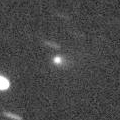
|
First return of a new periodic comet which brightened up to 16 mag in 2014. Now it is 17.0 mag (Apr. 27, Thomas Lehmann). It stays observable at 16-17 mag in good condition until July.
Date(TT) R.A. (2000) Decl. Delta r Elong. m1 Best Time(A, h)
May 8 12 9.71 8 33.4 1.415 2.211 130 16.9 21:04 ( 0, 63)
May 15 12 8.65 7 15.0 1.460 2.198 124 17.0 20:36 ( 0, 62)
|

|
Now it is 16.7 mag (Apr. 11, Toshihiko Ikemura, Hirohisa Sato). It will be fading slowly.
Date(TT) R.A. (2000) Decl. Delta r Elong. m1 Best Time(A, h)
May 8 18 7.47 -15 10.7 6.834 7.580 134 17.0 3:05 ( 0, 40)
May 15 18 2.69 -14 48.2 6.777 7.604 142 17.0 2:33 ( 0, 40)
|

|
Now it is 17.4 mag (Apr. 25, Telescope Live, El Sauce). It will brighten up to 9 mag, and will be observable in good condition in winter.
Date(TT) R.A. (2000) Decl. Delta r Elong. m1 Best Time(A, h)
May 8 22 52.34 -10 59.6 2.506 2.310 67 17.3 3:26 (293, 13)
May 15 23 4.33 -9 51.3 2.377 2.256 70 17.1 3:18 (294, 15)
|
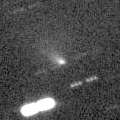
|
Now it is 17.0 mag (Apr. 14, Thomas Lehmann). It will be fading after this. In the Northern Hemisphere, it will be too low to observe in May. In the Southern Hemisphere, it stays observable in good condition after this.
Date(TT) R.A. (2000) Decl. Delta r Elong. m1 Best Time(A, h)
May 8 7 15.72 0 37.1 1.693 1.564 65 17.1 20:26 ( 75, 22)
May 15 7 36.95 -1 13.8 1.772 1.619 64 17.3 20:34 ( 75, 18)
|

|
Now it is 19.3 mag (Apr. 12, J. L. Virlichie, P. Traverse). It will brighten up to 15 mag from summer to autumn, and it will be observable in good condition.
Date(TT) R.A. (2000) Decl. Delta r Elong. m1 Best Time(A, h)
May 8 22 3.94 -8 0.1 2.475 2.457 77 17.3 3:26 (299, 24)
May 15 22 14.01 -7 22.3 2.379 2.441 81 17.1 3:18 (301, 26)
|
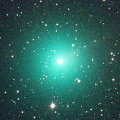
|
It brightened up to 7.3 mag in November (Nov. 7, Marco Goiato). Now it is fading. It has already faded down to 17.3 mag (Apr. 23, Thomas Lehmann). In the Northern Hemisphere, it stays observable in excellent condition for a long time. In the Southern Hemisphere, it stays locating extremely low after this.
Date(TT) R.A. (2000) Decl. Delta r Elong. m1 Best Time(A, h)
May 8 8 10.49 40 40.9 3.068 2.880 69 17.4 20:26 (113, 51)
May 15 8 22.02 39 50.6 3.218 2.952 65 17.7 20:34 (113, 46)
|

|
It has not been observed yet in this apparition. It will brighten up to 15 mag from summer to autumn. In the Southern Hemisphere, it stays observable for a long time. In the Northern Hemisphere, it is not observable until late June. But it will be observable in good condition after that.
Date(TT) R.A. (2000) Decl. Delta r Elong. m1 Best Time(A, h)
May 8 0 45.62 -9 26.6 2.481 1.864 42 17.8 3:26 (275, -9)
May 15 1 2.23 -7 24.2 2.408 1.826 44 17.5 3:18 (274, -7)
|
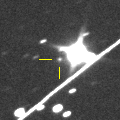
|
Now it is 17.0 mag (Apr. 30, ATLAS-HKO, Haleakala). It stays observable at 17-18 mag for a long time until 2024.
Date(TT) R.A. (2000) Decl. Delta r Elong. m1 Best Time(A, h)
May 8 14 59.97 -8 45.7 8.168 9.168 171 17.5 23:54 ( 0, 46)
May 15 14 55.39 -8 19.8 8.169 9.157 167 17.5 23:22 ( 0, 47)
|
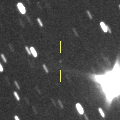
|
Now it is 18.5 mag (May 2, F. Kugel, J.-G. Bosch). It will brighten very rapidly, and it will be observable at 10 mag in good condition from October to December. In the Northern Hemisphere, it locates somewhat low at the high light.
Date(TT) R.A. (2000) Decl. Delta r Elong. m1 Best Time(A, h)
May 8 16 51.06 14 7.1 1.102 1.975 138 17.7 1:49 ( 0, 69)
May 15 16 48.40 15 28.2 1.037 1.926 140 17.5 1:19 ( 0, 70)
|

|
Now it is 17.0 mag (Apr. 22, ATLAS-HKO, Haleakala). It brightened rapidly. It stays 17-18 mag for a long time from 2021 to 2022. In the Southern Hemisphere, it stays observable in good condition for a long time. In the Northern Hemisphere, it is observable only until May.
Date(TT) R.A. (2000) Decl. Delta r Elong. m1 Best Time(A, h)
May 8 8 15.53 -7 34.5 5.567 5.514 81 17.5 20:26 ( 57, 27)
May 15 8 15.74 -7 46.4 5.659 5.502 75 17.6 20:34 ( 64, 21)
|

|
Now it is 19.7 mag (Apr. 19, F. Kugel, J.-G. Bosch). It will brighten up to 15.5 mag from summer to autumn. It stays observable for a long time.
Date(TT) R.A. (2000) Decl. Delta r Elong. m1 Best Time(A, h)
May 8 15 37.18 -15 45.5 1.234 2.236 170 17.9 0:35 ( 0, 39)
May 15 15 31.61 -15 12.5 1.191 2.201 176 17.6 0:02 ( 0, 40)
|
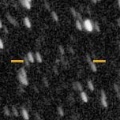
|
Now it is 17.5 mag (Apr. 24, Ken-ichi Kadota). It will brighten up to 15.5 mag in winter. In the Northern Hemisphere, it stays observable in good condition for a long time. It is not observable at all in the Southern Hemisphere.
Date(TT) R.A. (2000) Decl. Delta r Elong. m1 Best Time(A, h)
May 8 21 11.49 48 47.9 4.096 3.962 75 17.7 3:26 (232, 57)
May 15 21 12.05 51 23.9 4.009 3.919 77 17.6 3:18 (226, 60)
|
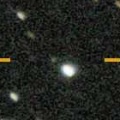
|
Now it is 17.2 mag (Apr. 28, ATLAS-HKO, Haleakala). It is expected to brighten up to 12 mag in 2023. In the Northern Hemisphere, it is observable in good condition in 2021. But it is observable only until November in 2022. In the Southern Hemisphere, it locates extremely low in 2021. But it will be observable in good condition at the high light.
Date(TT) R.A. (2000) Decl. Delta r Elong. m1 Best Time(A, h)
May 8 18 42.34 45 35.4 6.878 7.118 99 17.7 3:26 (192, 79)
May 15 18 38.78 45 58.0 6.789 7.069 102 17.7 3:08 (180, 79)
|
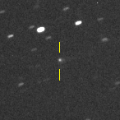
|
Now it is 17.6 mag (Apr. 11, Toshihiko Ikemura, Hirohisa Sato). It will brighten up to 16 mag in 2022. In 2021, it stays observable at 18 mag until September.
Date(TT) R.A. (2000) Decl. Delta r Elong. m1 Best Time(A, h)
May 8 13 28.02 4 0.6 2.462 3.368 149 17.7 22:22 ( 0, 59)
May 15 13 24.68 3 58.1 2.497 3.354 142 17.7 21:51 ( 0, 59)
|
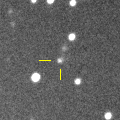
|
Now it is 17.5 mag (Apr. 18, Toshihiko Ikemura, Hirohisa Sato). Fading slowly. In 2021, it stays observable at 17-18 mag in good condition until early summer.
Date(TT) R.A. (2000) Decl. Delta r Elong. m1 Best Time(A, h)
May 8 12 56.94 -14 42.3 6.123 7.019 150 17.7 21:51 ( 0, 40)
May 15 12 55.84 -14 8.8 6.196 7.035 143 17.7 21:23 ( 0, 41)
|

|
First return of a new periodic comet observed at 17 mag in 2014. It has not been observed yet in this apparition. It is expected to brighten up to 17 mag from summer to autumn, and it will be observable in good condition.
Date(TT) R.A. (2000) Decl. Delta r Elong. m1 Best Time(A, h)
May 8 22 59.21 -4 33.3 1.926 1.723 63 17.8 3:26 (287, 16)
May 15 23 15.75 -2 14.5 1.866 1.708 65 17.7 3:18 (286, 18)
|
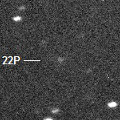
|
Now it is 18.0 mag (Apr. 18, Toshihiko Ikemura, Hirohisa Sato). It will be observable at 11 mag from winter to spring in 2022. In 2021, it is observable until July or August when it brightens up to 16-17 mag.
Date(TT) R.A. (2000) Decl. Delta r Elong. m1 Best Time(A, h)
May 8 10 19.36 14 51.3 2.692 3.094 103 17.8 20:26 ( 43, 64)
May 15 10 20.95 14 37.6 2.752 3.055 97 17.7 20:34 ( 56, 59)
|
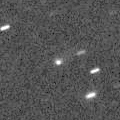
|
Now it is 17.1 mag (Apr. 18, Toshihiko Ikemura, Hirohisa Sato). It stays 17-18 mag for a long time from 2021 to 2023.
Date(TT) R.A. (2000) Decl. Delta r Elong. m1 Best Time(A, h)
May 8 10 36.96 12 3.8 4.453 4.875 108 17.7 20:26 ( 32, 64)
May 15 10 37.90 11 51.0 4.549 4.869 102 17.7 20:34 ( 47, 59)
|
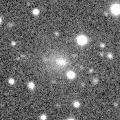
|
Brightened very rapidly up to 15.0 mag (Feb. 4, Michael Jager). Now it is fading. It hasl already faded down to 17.8 mag (Apr. 11, Toshihiko Ikemura, Hirohisa Sato). It is observable in good condition in the Northern Hemisphere. It locates low in the Southern Hemisphere.
Date(TT) R.A. (2000) Decl. Delta r Elong. m1 Best Time(A, h)
May 8 6 55.84 26 10.3 2.599 2.187 55 17.9 20:26 (102, 31)
May 15 7 11.59 25 32.2 2.691 2.218 52 18.1 20:34 (103, 27)
|
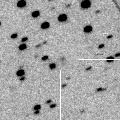
|
Now it is 18.2 mag (Apr. 19, Toshihiko Ikemura, Hirohisa Sato). In the Northern Hemisphere, it stays observable at 18 mag for a long time from 2021 to 2022. It is not observable in the Southern Hemisphere.
Date(TT) R.A. (2000) Decl. Delta r Elong. m1 Best Time(A, h)
May 8 17 49.61 53 27.6 6.826 7.082 100 17.9 2:47 (180, 72)
May 15 17 41.10 54 20.6 6.812 7.082 101 17.9 2:11 (180, 71)
|
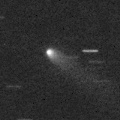
|
Now it is 18.6 mag (Apr. 4, Michael Jager). Although it is around the aphelion, it is much brighter than originally predicted.
Date(TT) R.A. (2000) Decl. Delta r Elong. m1 Best Time(A, h)
May 8 10 42.43 10 34.0 4.979 5.420 110 18.4 20:26 ( 28, 63)
May 15 10 42.38 10 24.3 5.087 5.422 104 18.5 20:34 ( 43, 59)
|
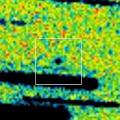
|
It was expected to brighten up to 13 mag from spring to summer. But actually, it is extremely faint as 19.0 mag (Mar. 22, A. C. Gilmore, P. M. Kilmartin). In the Southern Hemisphere, it stays observable in good condition for a long time. In the Northern Hemisphere, it is not observable until late August.
Date(TT) R.A. (2000) Decl. Delta r Elong. m1 Best Time(A, h)
May 8 0 29.83 -46 24.3 1.578 1.586 71 18.5 3:26 (311,-24)
May 15 1 14.18 -46 10.6 1.556 1.564 71 18.5 3:18 (308,-28)
|
|
![]()
 117P/Helin-Roman-Alu 1
117P/Helin-Roman-Alu 1 8P/Tuttle
8P/Tuttle C/2020 M5 ( ATLAS )
C/2020 M5 ( ATLAS ) C/2018 N2 ( ASASSN )
C/2018 N2 ( ASASSN ) 201P/LONEOS
201P/LONEOS C/2017 T2 ( PanSTARRS )
C/2017 T2 ( PanSTARRS ) 17P/Holmes
17P/Holmes C/2020 H6 ( ATLAS )
C/2020 H6 ( ATLAS ) C/2019 K7 ( Smith )
C/2019 K7 ( Smith ) C/2020 Y2 ( ATLAS )
C/2020 Y2 ( ATLAS ) C/2020 S3 ( Erasmus )
C/2020 S3 ( Erasmus ) C/2020 S8 ( Lemmon )
C/2020 S8 ( Lemmon ) 156P/Russell-LINEAR
156P/Russell-LINEAR C/2019 O3 ( Palomar )
C/2019 O3 ( Palomar ) C/2017 Y2 ( PanSTARRS )
C/2017 Y2 ( PanSTARRS ) C/2020 O2 ( Amaral )
C/2020 O2 ( Amaral ) C/2019 T3 ( ATLAS )
C/2019 T3 ( ATLAS ) C/2019 U5 ( PanSTARRS )
C/2019 U5 ( PanSTARRS ) C/2020 V2 ( ZTF )
C/2020 V2 ( ZTF ) 409P/2020 V1 ( LONEOS-Hill )
409P/2020 V1 ( LONEOS-Hill ) C/2021 A1 ( Leonard )
C/2021 A1 ( Leonard ) 413P/2020 W4 ( Larson )
413P/2020 W4 ( Larson ) C/2017 U7 ( PanSTARRS )
C/2017 U7 ( PanSTARRS ) 67P/Churyumov-Gerasimenko
67P/Churyumov-Gerasimenko C/2020 N1 ( PanSTARRS )
C/2020 N1 ( PanSTARRS ) 284P/McNaught
284P/McNaught C/2020 M3 ( ATLAS )
C/2020 M3 ( ATLAS ) 106P/Schuster
106P/Schuster C/2020 F2 ( ATLAS )
C/2020 F2 ( ATLAS ) 6P/d'Arrest
6P/d'Arrest C/2020 F7 ( Lemmon )
C/2020 F7 ( Lemmon ) 57P/du Toit-Neujmin-Delporte
57P/du Toit-Neujmin-Delporte C/2021 D2 ( ZTF )
C/2021 D2 ( ZTF ) C/2020 K1 ( PanSTARRS )
C/2020 K1 ( PanSTARRS ) 152P/Helin-Lawrence
152P/Helin-Lawrence C/2019 C1 ( ATLAS )
C/2019 C1 ( ATLAS ) P/2014 W12 ( Gibbs )
P/2014 W12 ( Gibbs ) 22P/Kopff
22P/Kopff 99P/Kowal 1
99P/Kowal 1 P/2020 U2 ( PanSTARRS )
P/2020 U2 ( PanSTARRS ) C/2016 Q2 ( PanSTARRS )
C/2016 Q2 ( PanSTARRS ) 47P/Ashbrook-Jackson
47P/Ashbrook-Jackson C/2020 K5 ( PanSTARRS )
C/2020 K5 ( PanSTARRS )![]()






















































